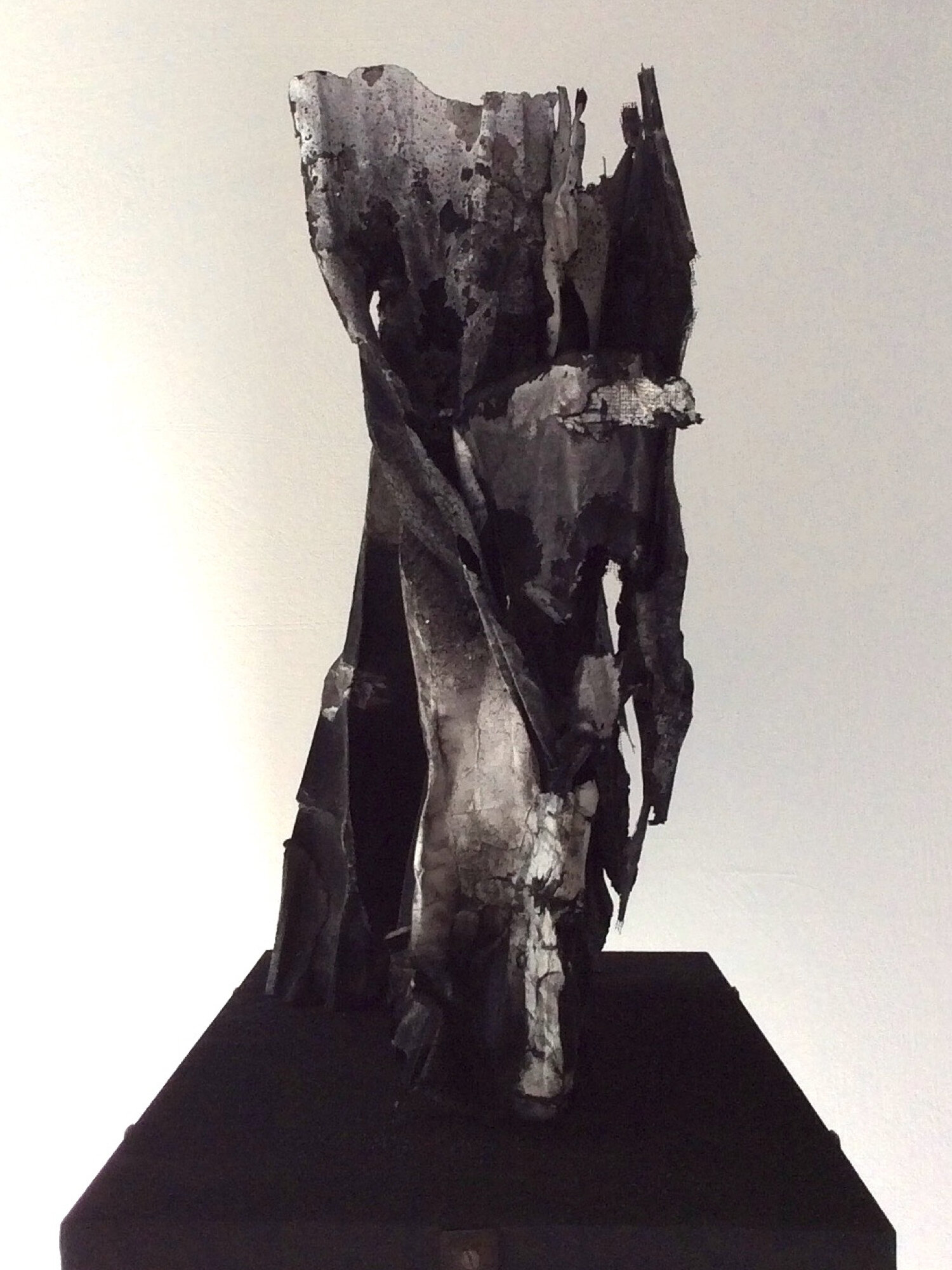SOLO EXHIBITION - 2017
fore/after
Whatever is true for space and time, this much is true for place: we are immersed in it and could not do without it. To be at all – to exist in any way – is to be somewhere, and to be somewhere is to be in some kind of place. Place is as requisite as the air we breathe, the ground on which we stand, the bodies we have. We are surrounded by places. We walk over and through them. We live in places, relate to others in them, die in them. Nothing we do is unplaced.
- Edward, S Casey (1)
erosion, 2017 (Detail)
Rives paper (300 gsm), charcoal, activated charcoal, Indian ink, mull, micropore plaster, linen and cotton thread
40 x 90.5 x 7 cm
charcoal, 2017
Canson paper (180 gsm), Rives paper (300 gsm), sand paper, charcoal, activated charcoal, Indian ink, mull, micropore plaster, linen and silk thread
250 x 151 x 7 cm
charcoal, 2017 (Detail)
Canson paper (180 gsm), Rives paper (300 gsm), sand paper, charcoal, activated charcoal, Indian ink, mull, micropore plaster, linen and silk thread
250 x 151 x 7 cm
whisper, 2017 (Foreground)
Chinese rice paper, sand paper, activated charcoal, document tape, copper and Plexiglas
44 x 58 x 15 cm
recollect II, 2017
Canson paper (180 gsm), charcoal, activated charcoal, Indian ink, fabric mesh, micropore plaster and cotton thread
66.3 x 82 x 3 cm
recollect I, 2017
Canson paper (180 gsm), charcoal, activated charcoal, Indian ink, fabric mesh, micropore plaster and cotton thread
66.3 x 87 x 3 cm
rock-face, 2017
Canson paper (180 gsm), charcoal, activated charcoal, Indian ink and micropore plaster
35.5 x 47 x 3 cm
residue, 2017
Canson paper (180 gsm), sand paper, fabric mesh, charcoal, activated charcoal and Indian ink.
29 x 56 x 2.5 cm
madame butterfly, 2017
Canson paper (180 gsm), charcoal, activated charcoal, Indian ink, micropore plaster and cotton thread
35.5 x 50.4 x 2 cm
change point, 2017
Canson paper (180 gsm), charcoal, activated charcoal, Indian ink, micropore plaster and cotton thread
43 x 66 x 2 cm
erosion, 2017
Rives paper (300 gsm), charcoal, activated charcoal, Indian ink, mull, micropore plaster, linen and cotton thread.
40 x 90.5 x 7cm
lullaby, 2017
Canson paper fibres, sanding paper, activated charcoal, Indian ink, mull and linen thread
36 x 94 x 3 cm
imagine, 2017 (Side view)
Canson paper (180 gsm), Fabriano paper (160 gsm), sand paper, charcoal, activated charcoal, Indian ink, fabric mesh, mull, copper and Plexiglas
40 x 55 x 25 cm
imagine, 2017 (Back view)
Canson paper (180 gsm), Fabriano paper (160 gsm), sand paper, charcoal, activated charcoal, Indian ink, fabric mesh, mull, copper and Plexiglas
40 x 55 x 25 cm
imagine, 2017 (Front view, detail)
Canson paper (180 gsm), Fabriano paper (160 gsm), sand paper, charcoal, activated charcoal, Indian ink, fabric mesh, mull, copper and Plexiglas
40 x 55 x 25 cm
here elsewhere, 2017
Tracing paper and activated charcoal
58 x 41.8 x 3 cm
elsewhere here, 2017
Tracing paper and activated charcoal
58 x 41.8 x 3 cm
here elsewhere, 2017 (Detail)
Tracing paper and activated charcoal
58 x 41.8 x 3 cm
elsewhere here, 2017 (Detail)
Tracing paper and activated charcoal
58 x 41.8 x 3 cm
Since contemplating how to go about ‘placing’ the body of work for this exhibition, I found myself continuously back at the beginning: the beginning of my challenge to question my own perceptions of what contemporary drawing might be. While focusing on the substance of charcoal as a drawing medium – and specifically its capacity as a natural filter, based on its extended surface area – the exploration process developed into an intimate engagement with ‘surface’. (2) The retracing of previous steps involved a specific concern with the murmurings of the mind series, which dealt with place and memory. (3)
Drawn in by the simplicity, and perhaps also the sense of anticipation, of the initial state of ‘pre-knowing’, I was challenged to look anew. Immersed in the process of engaging with the materiality of surface, a back-and-forth fluidity of experiential recognition comes into play – both consciously and subconsciously. In a sense then, this continuous process of exploration creates a layering of fore/afters. For me, much like the natural processes of life and learning … the getting to know.
Edward Casey suggests that continuous reflection on place results in our recognition of it ‘to be something not merely characterisable but actually experienced in qualitative terms. These terms, for example, color, texture and depth are known to us only in and by the body that enters and occupies a given place’. (4) However, I am not necessarily dealing with the literal physicality of place, but rather place as a metaphorical construct – a psychological, spiritual or intellectual place, perhaps. When considering the nature of a visual language – of line, tone, texture, contrast – reducing the image to surface arguably results in the mark itself becoming representative of a sense of place. The mark creates the possibility of witnessing the/a place, therefore creating an experience ‘in qualitative terms’, as Casey suggests above. Perhaps this reduction requires lingering in order to ‘see’ …
Casey, ES. 1998. The fate of Place: A Philosophical History. Berkeley: University of California Press, p. ix.
These concerns were the driving force that energised the development of processes and influenced decisions which shaped the work for the previous exhibition, fragile equilibriums (2014).
A series within the body of work for fragile equilibriums.
Casey 1998: 204.
















